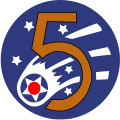| 403d Bombardment Squadron | |
|---|---|
 403d Squadron B-17F Flying Fortress, Mustang [a] | |
| Active | 1941–1946; 1958–1960; 1960–1961 |
| Country | |
| Branch | |
| Role | Bombardment |
| Engagements | Southwest Pacific Theater |
| Decorations | Distinguished Unit Citation Philippine Presidential Unit Citation |
| Insignia | |
| Patch with 403d Bombardment Squadron emblem [b] [1] |  |
| 403d Bombardment Squadron emblem (World War II) [2] |  |
The 403d Bombardment Squadron is an inactive United States Air Force unit. It was last assigned to the 43rd Bombardment Wing at Carswell Air Force Base, Texas, where it was inactivated on 1 January 1961.
Contents
- History
- World War II
- Strategic Air Command
- Lineage
- Assignments
- Stations
- Aircraft
- Awards and campaigns
- See also
- References
- Bibliography
The squadron was first activated in January 1941 as the 13th Reconnaissance Squadron, one of the original squadrons of the 43rd Bombardment Group. Following the Attack on Pearl Harbor, the squadron participated in antisubmarine patrols until January 1942, when it moved to Australia and the Southwest Pacific Theater. Shortly after it arrived in Australia, the squadron was redesignated the 403d Bombardment Squadron. It moved forward with US forces through New Guinea and the Philippines, moving to Ie Shima shortly before V-J Day for operations against Japan. It earned a Distinguished Unit Citation and a Philippine Presidential Unit Citation for combat operations. The squadron was inactivated in the Philippines in April 1946.
The squadron was reactivated as a Strategic Air Command Boeing B-47 Stratojet unit in Arizona from 1958 to 1960. It was activated again at Carswell in 1960 to begin conversion to the Convair B-58 Hustler, but was inactivated before becoming operational.




